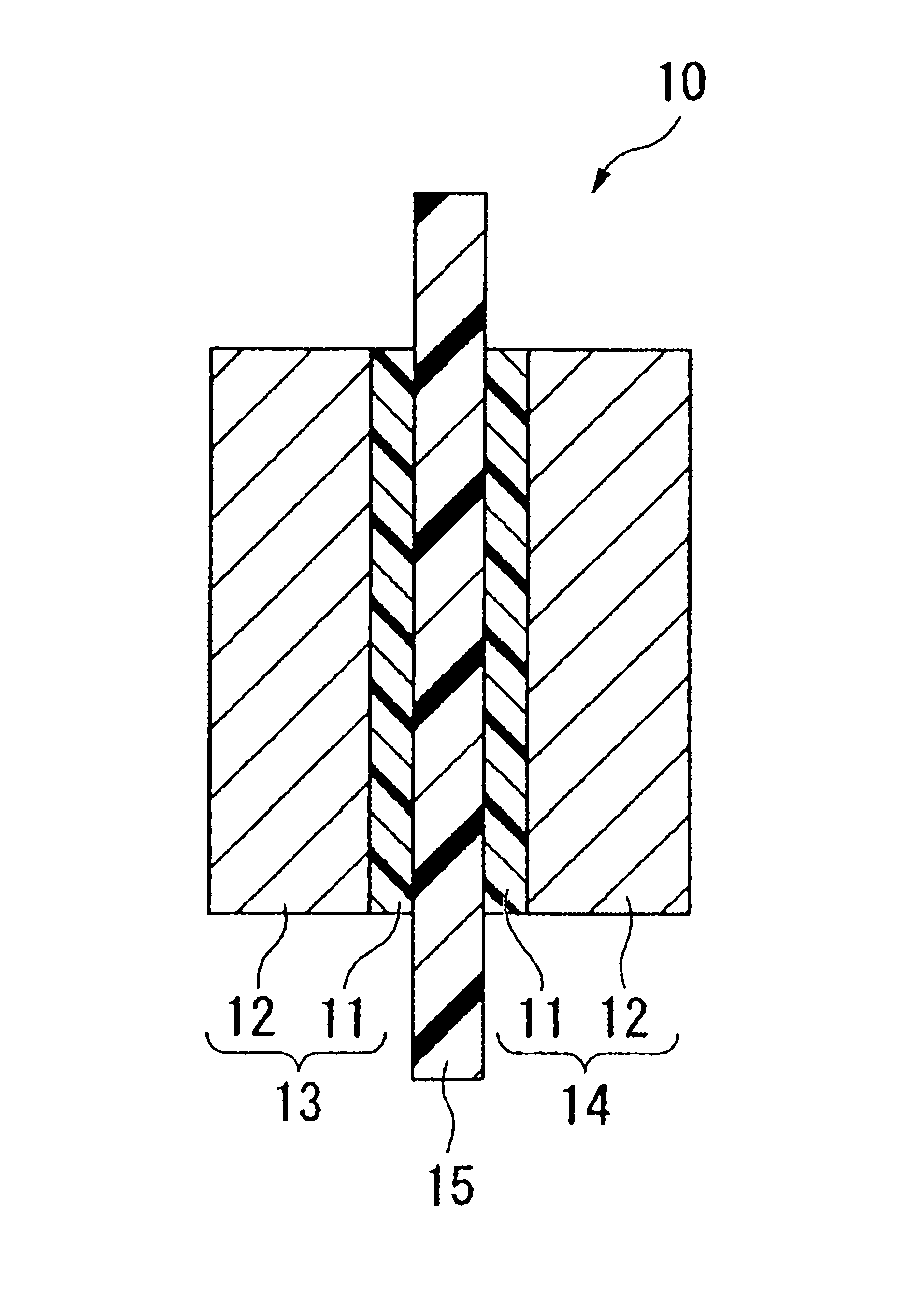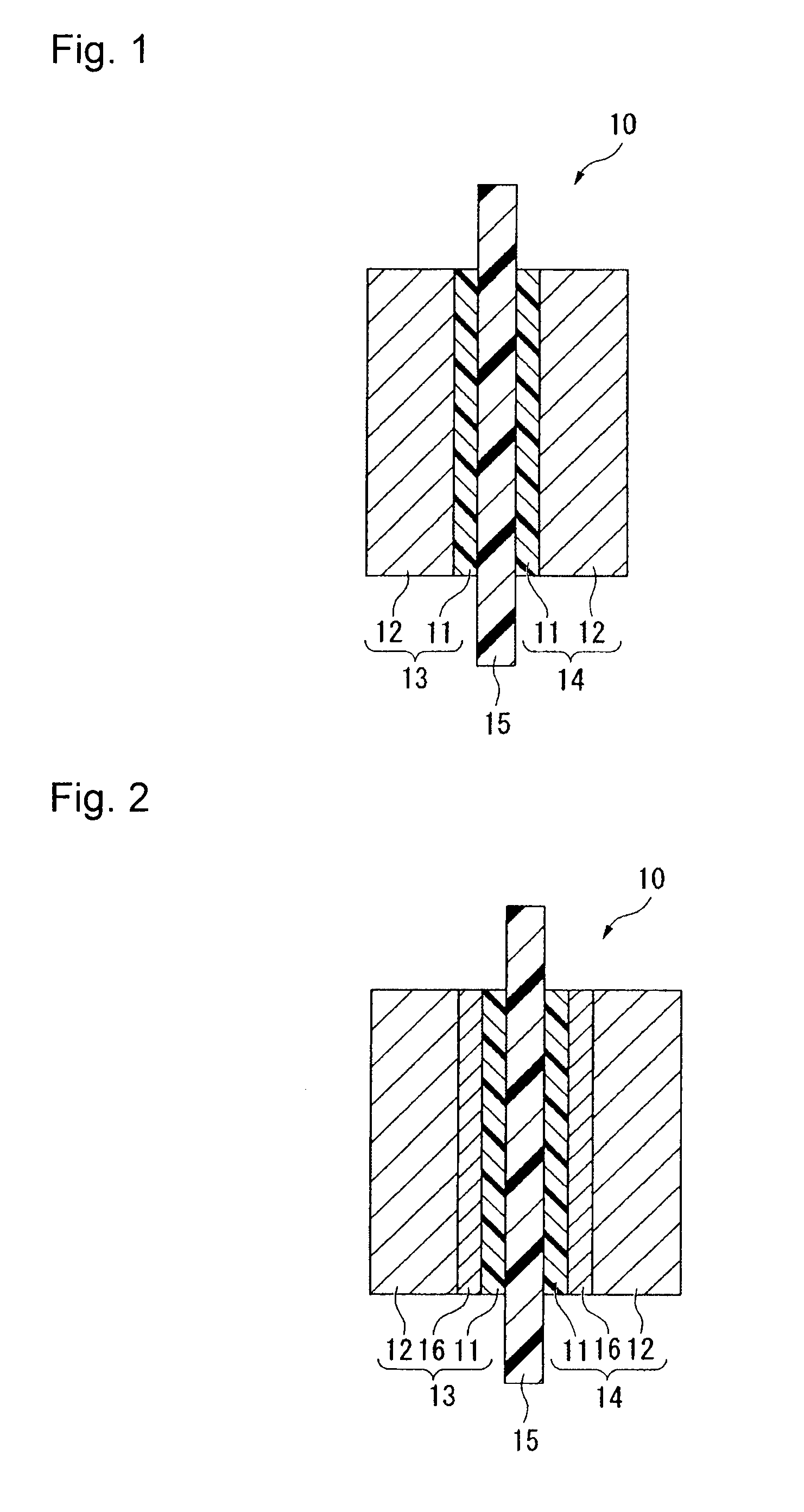Electrolyte material, liquid composition and membrane/electrode assembly for polymer electrolyte fuel cell
a fuel cell and electrolyte technology, applied in the direction of cell components, final product manufacturing, sustainable manufacturing/processing, etc., can solve the problems of low power generation characteristics, output voltage, and the insufficient power generation characteristics of the electrolyte fuel cell employing the polymer (2) as a catalyst layer under low or no humidity conditions, and achieve excellent power generation characteristics.
- Summary
- Abstract
- Description
- Claims
- Application Information
AI Technical Summary
Benefits of technology
Problems solved by technology
Method used
Image
Examples
example 1
[0197]Into a stainless steel autoclave having an internal capacity of 125 mL, 9.15 g of compound (m21-1), 45.65 g of compound (m1-1) and 6.4 mg of compound (i-2) were charged, followed by sufficient deaeration under cooling with liquid nitrogen. Then, the temperature was raised to 40° C. and held for 24.5 hours, and then the autoclave was cooled to terminate the reaction.
[0198]The formed product was diluted with compound (s-1), and n-hexane was added thereto to agglomerate a polymer, followed by filtration. Then, the polymer was stirred in compound (s-1), re-agglomerated with n-hexane and dried under reduced pressure overnight at 80° C. to obtain polymer (F-1). The yield was 4.5 g. The density of polymer (F-1) was measured. The results are shown in Table 1.
[0199]Polymer (F-1) was immersed in an aqueous solution containing 20 mass % of methanol and 15 mass % of potassium hydroxide at 50° C. for 40 hours to hydrolyze and convert —SO2F groups in polymer (F-1) to —SO3K groups. Then, the...
example 2
[0201]Into a stainless steel autoclave having an internal capacity of 125 ml, 9.01 g of compound (m21-1), 50.01 g of compound (m1-1) and 5.6 mg of compound (i-2) were charged, followed by sufficient deaeration under cooling with liquid nitrogen. Then, the temperature was raised to 40° C., followed by stirring for 24 hours, and the autoclave was cooled to terminate the reaction.
[0202]The formed product was diluted with compound (s-1), and n-hexane was added thereto to agglomerate a polymer, followed by filtration. Then, the polymer was stirred in compound (s-1), re-agglomerated with n-hexane and dried under reduced pressure overnight at 80° C. to obtain polymer (F-2). The yield was 5.7 g. The density of polymer (F-2) was measured. The results are shown in Table 1.
[0203]Using polymer (F-2), polymer (H-2) and liquid composition (D-2) were obtained in the same manner as in Example 1. The ion exchange capacity of polymer (H-2) was measured. The results are shown in Table 1.
example 3
[0204]Into a stainless steel autoclave having an internal capacity of 125 ml, 9.0 g of compound (m21-1), 69.27 g of compound (m1-1) and 10.0 mg of compound (i-2) are charged, followed by sufficient deaeration under cooling with liquid nitrogen. Then, the temperature is raised to 40° C., followed by stirring for 26 hours, and the autoclave is cooled to terminate the reaction.
[0205]The formed product is diluted with compound (s-1), and n-hexane is added thereto to agglomerate a polymer, followed by filtration. Then, the polymer is stirred in compound (s-1), re-agglomerated with n-hexane and dried under reduced pressure overnight at 80° C. to obtain polymer (F-3). The yield is 8.0 g. The density of polymer (F-3) is measured. The results are shown in Table 1.
[0206]Using polymer (F-3), polymer (H-3) and liquid composition (D-3) are obtained in the same manner as in Example 1. The ion exchange capacity of polymer (H-3) is measured. The results are shown in Table 1.
PUM
| Property | Measurement | Unit |
|---|---|---|
| density | aaaaa | aaaaa |
| ion exchange capacity | aaaaa | aaaaa |
| ion exchange | aaaaa | aaaaa |
Abstract
Description
Claims
Application Information
 Login to View More
Login to View More - R&D
- Intellectual Property
- Life Sciences
- Materials
- Tech Scout
- Unparalleled Data Quality
- Higher Quality Content
- 60% Fewer Hallucinations
Browse by: Latest US Patents, China's latest patents, Technical Efficacy Thesaurus, Application Domain, Technology Topic, Popular Technical Reports.
© 2025 PatSnap. All rights reserved.Legal|Privacy policy|Modern Slavery Act Transparency Statement|Sitemap|About US| Contact US: help@patsnap.com



